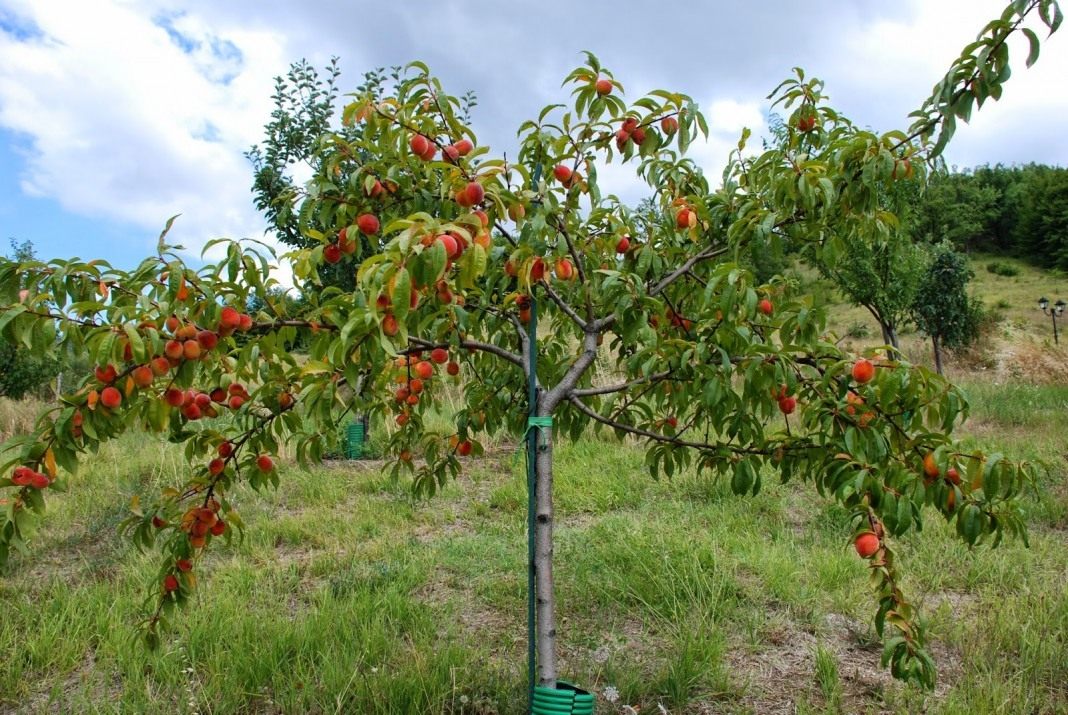Peach is a capricious culture, gardeners have to make a lot of efforts to get a good harvest. From spring to the end of summer, you need to constantly monitor the health of the tree, timely fertilize, ennoble the soil and carry out pruning. Autumn care is one of the most crucial stages; counting on a plentiful harvest in the next season is possible only with the correct preparation of peach for the winter.
Content
How to care for a peach in autumn
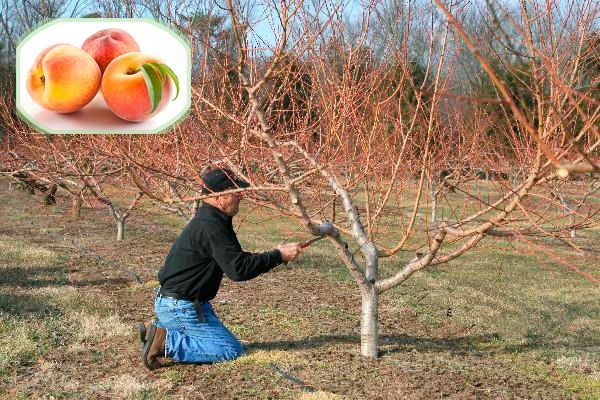 The list of standard autumn procedures includes fertilizing, watering, loosening the soil, as well as spraying peach trees from diseases and pests. Young, not yet fruiting trees need to organize reliable protection against frost. Each gardener has to make a work plan independently, taking into account the climate and weather conditions of the region, as well as the features of the peach variety.
The list of standard autumn procedures includes fertilizing, watering, loosening the soil, as well as spraying peach trees from diseases and pests. Young, not yet fruiting trees need to organize reliable protection against frost. Each gardener has to make a work plan independently, taking into account the climate and weather conditions of the region, as well as the features of the peach variety.
Beginning gardeners should remember - non-compliance with the rules of agricultural technology leads not only to a decrease in productivity, but also to the loss of trees. Updating a garden is a time consuming process. Therefore, all recommended procedures must be performed without sparing energy. Difficulties can arise only in the first couple of years, then peach care will become a habit in the fall.
How to care for soil
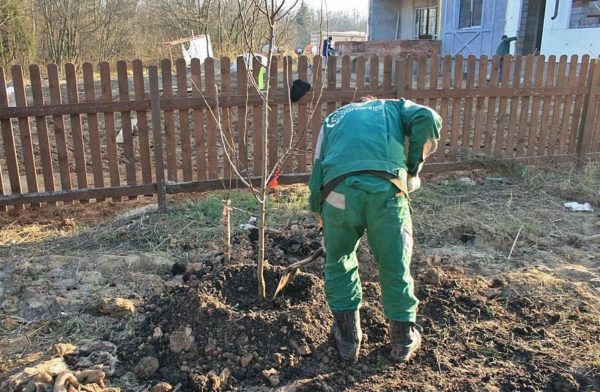 Dig the earth around the tree 10-15 days before the first frost. The procedure helps to lift out insect parasites that climb into the upper layers of the soil for wintering. The soil is dug up to a depth of 30 cm, very tightly, the degree of pest damage at low temperatures will depend on this. In the near-trunk zone, you should dig very carefully, without damaging the roots.
Dig the earth around the tree 10-15 days before the first frost. The procedure helps to lift out insect parasites that climb into the upper layers of the soil for wintering. The soil is dug up to a depth of 30 cm, very tightly, the degree of pest damage at low temperatures will depend on this. In the near-trunk zone, you should dig very carefully, without damaging the roots.
Inverted clods of the earth do not need to be smashed or leveled with a rake, frost gradually loosens the soil, which allows moisture to go into the ground without any obstacles. The first month of winter in most regions is accompanied by temperature drops, snowfall and thaws, often replacing each other. If you immediately loosen the lumps, from weather changes the top layer of the earth will turn into a dense crust that does not allow air and moisture to pass, which will negatively affect the further development of the tree.
Peach dressing in the fall
In order for the winter to go well, the peach needs to be fed, mineral fertilizers should be applied first. Around the stem, having indented it from 30 cm, pit up to 25 cm in width and depth (as the tree grows older, the dimensions of the grooves gradually increase). First, phosphorus is introduced, it is poured with a 4 cm layer of soil, potassium is added and again covered with earth. You can not alternate fertilizers, but take the prepared phosphorus-potash mixture, mix it with part of the dug soil, fill it in the pits and cover with the rest of the earth.
The application of organic fertilizers is very convenient to combine with digging - compost or manure is evenly scattered around the peach trunk, leveled with a rake and dig the ground as described above. The amount of any fertilizer is calculated based on the age of the tree and the condition of the soil. Do not exceed the norm, the natural process of preparing a peach for wintering is disrupted.
| Tree age | Fertilizer rates |
| Up to 3 years | 10 kg of organics, 75 gr. superphosphate, 30 gr. potassium salt. |
| 4-7 years | 15 kg of manure or compost, 125 gr. superphosphate, 45 gr. potassium salt and 65 gr. ammonium nitrate. |
| 7–9 years old | 25-30 kg of organics, 160 gr. superphosphate, 65 gr. potassium salt. |
| From 9 years and older | 35 kg of organic fertilizers, 180 gr. superphosphate, 100 gr. potassium salt and 120 gr. ammonium nitrate. |
After adding minerals and organics, it is advisable to conduct a foliar feeding session (after leaf fall). You can take urea (50 gr. Per bucket of water). If the peach was planted in the spring, with the correct preparation of the soil, then fertilizing it in the autumn is not necessary, feeding will be required next year. After autumn planting the first full feeding is carried out after a year and a half.
Phosphorus is added every 2 seasons and only in autumn. It is permissible to use organics every 3 years, but if the soil is already fertile, less often or reduce the dosage. It is impossible to fertilize young trees with fresh (not rotted) manure, it will burn the roots. With old peaches, they do the opposite, the roots are already strong, they have gone far into the ground, they are not afraid of burns.
How and when to water a peach
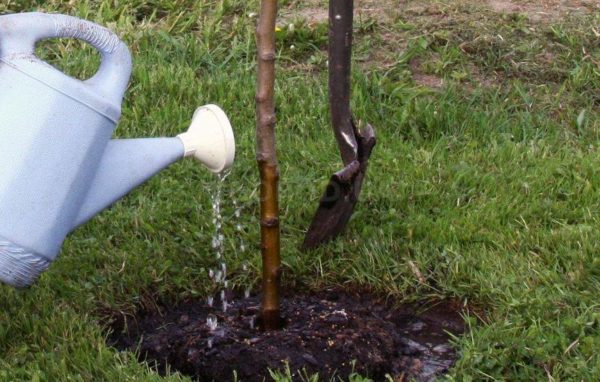 Most of the binding peach roots are at a depth of 65 cm, the earth needs to be moistened to the same level. Water the tree after leaf fall when it is no longer growing. It is important to catch up to the first autumn frosts, later watering threatens with partial or complete freezing out of the roots, branches and trunk, so as not to be mistaken, see the long-term weather forecast. Water is poured gradually and only at the root.
Most of the binding peach roots are at a depth of 65 cm, the earth needs to be moistened to the same level. Water the tree after leaf fall when it is no longer growing. It is important to catch up to the first autumn frosts, later watering threatens with partial or complete freezing out of the roots, branches and trunk, so as not to be mistaken, see the long-term weather forecast. Water is poured gradually and only at the root.
Peaches should be watered in moderation, it is impossible to bring the soil to waterlogging, in such conditions the trees will not winter well, there will be a risk of developing fungal and viral diseases. In the case when the garden is heavy, clay soil or if the trees grow in a lowland, it is better to refuse watering. Another reason not to carry out the procedure is rainy autumn. A peach planted in sandy loam or podzolic soil is in dire need of winter moisture.
Peach pruning and crown shaping
Peach is very picky about sunlight, at the same time it has a high growth force. If pruning is not done in a timely manner, the tree will grow a large number of stems, on which many fruit buds are formed. Due to the crop overload, the branches will break, the peach will weaken and will not be able to overwinter normally. Before Planning autumn pruning, study the features of crown formation.
Cup type
Most of the peach varieties are crown-shaped in the shape of a bowl — the trees are quite thin, well-lit, and easy to care for and harvest. In spring, the procedure is carried out only in the south, in other areas - in August or in the first half of autumn (provided that the weather is warm without frequent rainfall). It will take at least 4 years to form, it should start 1-2 years after planting, depending on the height of the seedling:
- Pinch the main trunk at a height of 80 cm, leave the lower 60 cm for the stem, and the top 20 for skeletal branches. The strongest 3 or 4 side branches are left, they can be shortened to 15 cm. The remaining shoots, as well as all the buds, are completely removed. In summer, stalks growing upward are broken.
- Next year, all skeletal branches are brought to the same length. The stalks growing in the summer on the stems and skeletal branches, shorten to 10 cm.
- In the third year, only the strongest branches, located half a meter from the base of the skeletal branches, are left, shorten them to 50 cm. These will be the branches of the second plan.
In the last year, they are laying branches of 3 orders. In summer, shoots growing down, inward and horizontally are removed. In the future, thinning and preventive trimming should be carried out annually. Peach bears fruit well for about 13 years, then it needs to be rejuvenated.The procedure is acceptable when the amount of the crop will noticeably decline, while the peach itself will be healthy and well-groomed.
Household pruning
This method is more suitable for varieties with a dense placement of the kidneys. The procedure consists in shortening the weakened annual growths by 15–20 cm, while normal branches need to be cut so that 3 to 8 groups of fruit buds remain (depending on the strength of growth). The described type of haircuts can be combined with pruning for substitution - strong fruit shoots are shortened in an economic way, and weak, growth and mixed only for 3 buds.
Combining 2 types of pruning, you can form the optimal crown for peach varieties prone to severe thickening. Never use critical pruning schemes for young trees. When removing a significant part of the branches, the beginning of fruiting will have to wait more than 4 years. Before the first flowering, it is desirable to thin out the crown no more than once a year.
Autumn pruning of shaped peach
The procedure is carried out from late September to mid-October, so that the wounds have time to heal before the onset of frost. You can use only sharp, clean and sanitized garden tools (scissors, delimbers, pruners or saws). Places of cuts are necessarily covered with garden varnish or oil paint, in extreme cases, they are treated with crushed wood ash.
In autumn, diseased, damaged, and dried branches are removed (pests, fungal spores, and pathogenic bacteria can winter there). Weakened shoots, thickening the crown, and tops are subject to pruning; in the winter they will pick up too many useful substances. First, branches containing only flower or sprout buds are sheared, then the crown is thinned. Any pruning is carried out only in warm and dry weather.
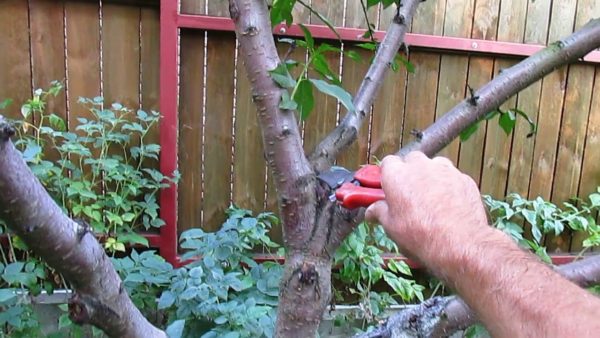
The optimal height of an adult peach is 3, 5 meters, the crown should be underestimated by transferring it to the sides. In regions with severe winters, strong pruning is performed in the fall for better nutrition distribution. In the middle zone or in the south, as well as in the case of winter-hardy varieties that can withstand temperatures of up to 40 degrees, this type of haircut is not necessary.
Autumn peach processing
The main processing of peach is carried out in the fall, in the spring the result is fixed. Summer spraying is aimed at eliminating ailments or parasites in the most dangerous periods (adverse weather or epidemics).
Autumn is a wet season, high humidity is an ideal environment for the development of spores. If you do not suppress the activity of fungi before wintering, in February they will penetrate the bark of the tree, slow down the process of sap flow, the buds and flower ovaries will not receive moisture and nutrients. Even with timely spring intervention, saving peaches will be difficult.Before starting treatment, you should carefully prepare the garden and trees - remove all fallen leaves and fruits, pruning, whitening trunks. Spraying is carried out in calm, calm weather before lunch. It is important that there is no rain in the next 2-3 days. Protective clothing and a fine sprayer are prepared for work. First, the trunk is treated, then the branches, and the last, if necessary, the soil. It is advisable to change the preparations during the year so that insects, pathogenic bacteria and fungi do not develop resistance.
For comprehensive protection of peach, gardeners prepare mixtures based on insecticides and fungicides.First you need to check the possibility of combining certain drugs, all the necessary information is presented on the packages. If you neglect this rule, spraying may not give a positive result or even harm the tree. Recommended means for spraying peach in the fall:
- to cope with almost all insects, at different stages of their development, carbamide treatment (50 gr. per 10 liters of water) will help;
- a tree treated with an emulsion of diesel fuel is covered with a protective film that prevents the development of pests hidden in leaves and bark. Parasites will come out. To prepare the solution, you need 2 kg of clay, 600 g. diesel fuel, 2 tablespoons of liquid soap per 10 liters of water. Chemistry can be replaced by the infusion of garlic, insects do not tolerate its smell;
- To combat fungi, peach should be sprayed with 3% Bordeaux liquid (consumption from 2 to 12 liters of solution per tree) or other copper-containing preparations.
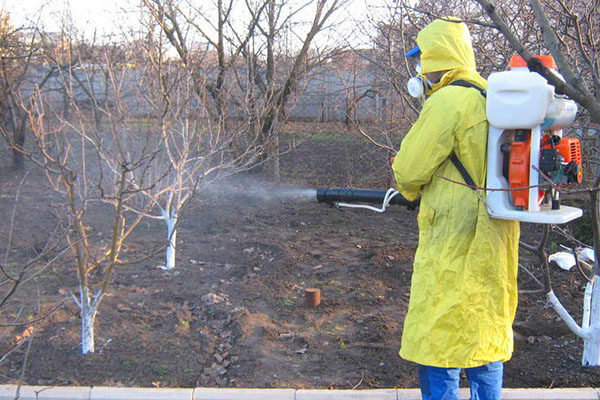
So that you can individually choose the means of protection, keep in mind that the greatest danger to peach is represented by diseases such as moniliosis, powdery mildew, kleasterosporiosis and the main risk is curly leaves. The tree is most often affected by ticks, different types of aphids, weevils, eastern codling moth and fruit moth. When buying funds, consult with the seller, choosing doses, focus on prevention and be sure to follow safety precautions.
How to protect a peach from the sun and frost
Direct rays of the sun, regardless of the season, can leave burns on the bark, young branches, and in some cases on the roots. Places of damage usually freeze, in the spring the tree spends a lot of energy on restoration, which negatively affects the quantity and quality of the crop. Especially a peach is exposed to sunlight after scanty or uneven autumn watering, burns appear more often if the tree grows on poor soils.
Protecting a peach from burns is easy - in autumn you need to whiten the stamb and the base of skeletal branches with a mixture of 2 kg of lime (slaked), 250 gr. copper sulfate and 30 gr. Laundry soap on a bucket of water. To achieve the best effect (protection of fruit buds and bark) it is advisable to spray the tree with lime milk. Trunks of young peaches can be wrapped with sheets of cardboard, spruce branches, straw, stalks of sunflower, reeds or corn. Tie up the material used loosely, but so that it holds well.
How to cover a peach for the winter depends on the climate of the region and the location of the garden. In the south, there is a fairly high earthing up and the creation of a volumetric snowdrift as snow falls. In cities with frosty and snowless winters, as well as in areas blown by a cold wind to preserve heat at the roots, the trunk circle is mulched with a mixture of sawdust and ash (layer up to 15 cm).
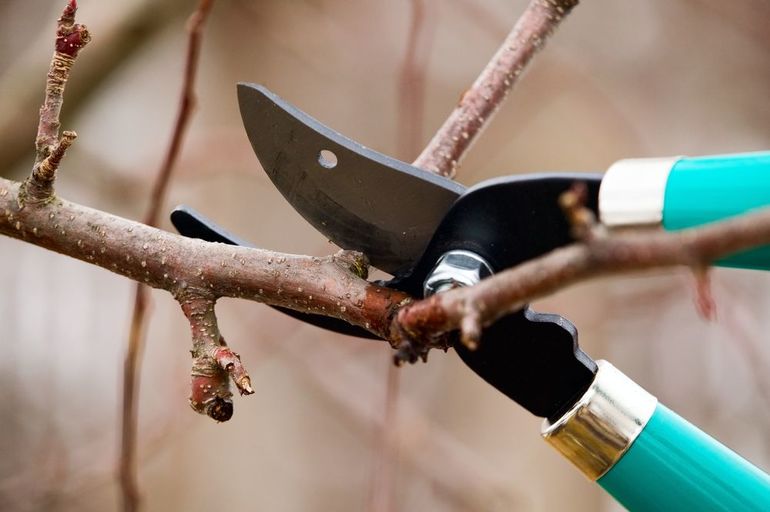 You may be interested in:
You may be interested in:The trunk of a grown peach can be wrapped in burlap. It is easy to cover a small tree with a cardboard box, fill the voids with straw. Another option - several pegs are driven in around the seedling, roofing felt or slate are mounted on them, the top of the structure is covered with polyethylene. The material for shelter must be breathable, otherwise you need to make holes in it yourself.
Preparing peaches for winter has 2 fundamentals - pruning and spraying, but you should not neglect soil digging, watering and top dressing. All procedures are designed to strengthen the tree, which means they need to be performed in a comprehensive manner. Finally, we note once again - there are no special differences in the shelter of peach for the winter in Siberia, the Urals, the Volga Region and the Moscow Region.Serious warming is not required only in areas with warm and snowy winters, for example, in the Krasnodar Territory or in the Crimea.


